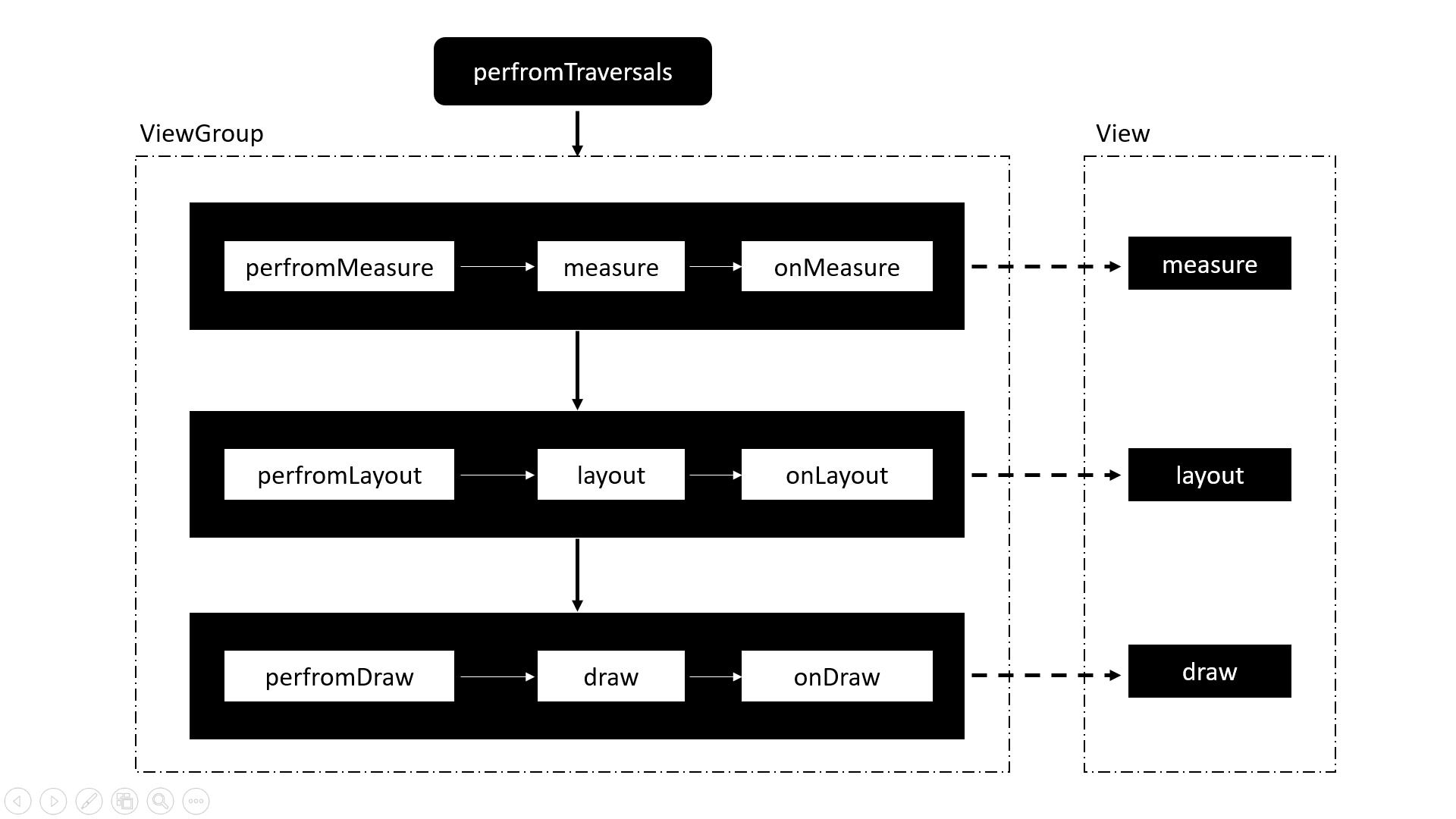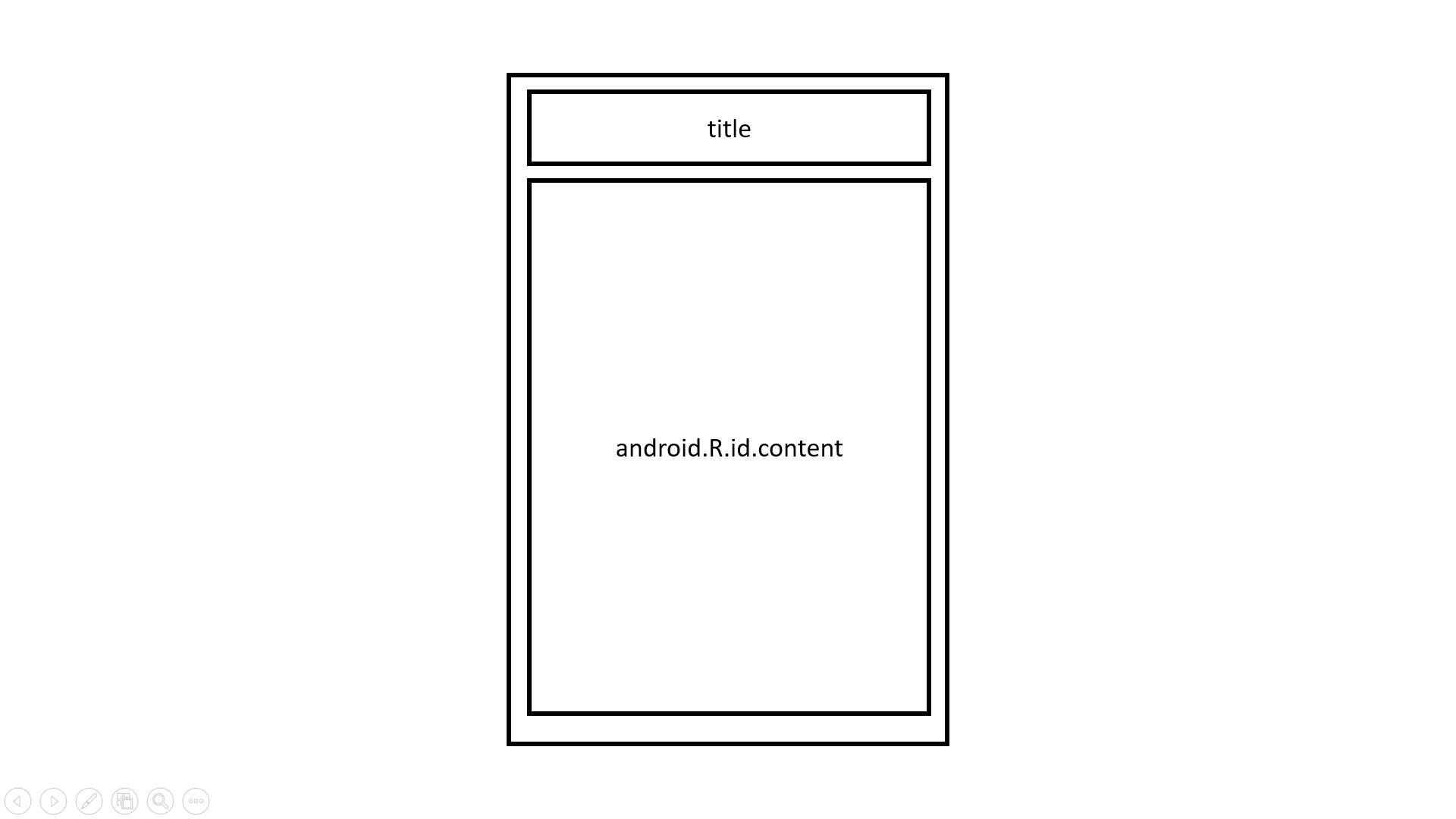Android艺术开发探索第四章——View的工作原理(上)
Posted 刘某人程序员
tags:
篇首语:本文由小常识网(cha138.com)小编为大家整理,主要介绍了Android艺术开发探索第四章——View的工作原理(上)相关的知识,希望对你有一定的参考价值。
android艺术开发探索第四章——View的工作原理(上)
这章就比较好玩了,主要介绍一下View的工作原理,还有自定义View的实现方法,在Android中,View是一个很重要的角色,简单来说,View是Android中视觉的呈现,在界面上Android提供了一套完整的GUI库,里面有很多控件,但是有时候往往并不能满足于需求,所以只有自定义View了,我们会简单的说下流程,然后再去实践
除了View的三大流程之外,View常见的回调方法也是必须掌握的,比如构造方法,onAttach,onVisibilityChanged,onDetach,另外对于一些有滑动效果的自定义View,还要处理滑动事件和滑动冲突,总的来说,自定义View有几种固定的类型,View或者ViewGroup,有的直接重写原生控件,这个就要看需求了,好的,我们直接开始吧!
一.初识ViewRoot和DecorView
在正式介绍View的三大流程之前,我们还是要了解一些基本的概念,所以本章会说下ViewRoot和DecorView
ViewRoot对应于ViewRootImpl类,他是连接WindowManager和DecorView的纽带,View的三大流程都是通过ViewRoot来完成的,在ActivityThread中,当Activity被创建完毕后,会将DecorView添加到Window值班费,同时会创建ViewRootImpl对象,并将ViewRootImpl对象和DecorView建立联系,这个可以参照官网:
root = new ViewRootImpl(view.getContext(),display);
root.setView(view,wparams,panelParentView);View的绘制流程从ViewRoot的perfromTraversals方法开始,他警告measure,layout和draw三个过程才能将View画出来,,其中measure测量,layout确定view在容器的位置,draw开始绘制在屏幕上,针对perfromTraversals的大致流程,可以看图

图中的perfromTraversals会依次调用perfromMeasure,perfromLayout,perfromDraw,他们分别完成顶级View的measure,layout和draw这三大流程,其中在perfromMeasure中会调用measure方法,在measure方法中又调用onMeasure,这个时候measure流程就从父容器传递到子元素了,这样就完成了一次measure过程,接着子元素会重复父容器的measure过程,如此反复的完成了整个View树的遍历,同理,其他两个也是如此,唯一有点区别的是perfromDraw的传递过程是在draw反复中通过dispatchDraw来实现的,不过这并没有什么本质的区别
measure過程决定了View的宽高,Measure完成之后可以通过getMeasureWidth和getMeasureHeight来获取View测量后的高宽,在所有的情况下塔几乎都是等于最终的宽高,但是特殊情况除外,这点以后说,layout过程决定了view的四个顶点的坐标和实际View的宽高,完成之后,通过getTop,getLeft,getRight,getBottom获得,,Draw决定了View的显示,只有draw方法完成了之后,view才会显示在屏幕上
如下图,顶级View DecorView,一般情况下他内部会包含一个竖直方向的LinearLayout,这里面有上下两部分,上面是标题栏,下面是内容,在Activity中,我们可用通过setContentView设置布局文件就是放在内容里,而内容栏的id为content,因此我們可以理解为实际上是在setView,那如何得到content呢?你可以ViewGroup content = findviewbyid(android.R.id.content),如何得到我们设置的View呢:content.getChildAt(0),同时,通过源码我们可用知道,DeaorView其实就是一个FrameLayout,View层事件都先经过DecorView,然后传递给View

二.理解MeasureSpec
为了更好的理解View的测量过程,我们还需要理解MeasureSpec,从名字上看,MeasureSpec看起来像“测量规格”或者“测量说明书”,不管怎么翻译,他看起来就好像是或多或少的决定了View的测量过程,通过源码可以发现,MeasureSpec的确参与了View的测量过程,读者可能有疑问,MeasureSpec是干什么的呢?MeasureSpec在很大程度上决定了一个View的尺寸规格,之所以说很大程度上是因为这个过程还收到了父容器的影像,因为父容器影像MeasureSpec的创建过程,在测量过程中,系统会将View的LayoutParams根据父容器所施加的规则转换成对应的MeasureSpec,然后再根据这个measureSpec来测量出View的宽高,MeasureSpec看起来有点复杂,其实他的实现很简单,我们来详细分解一下
1.MeasureSpec
MeasureSpec代表一个32位int值,高两位代表SpecMode,低30位代表SpecSize,SpecMode是指测量模式,而SpecSize是指在某个测量模式下的规格大小,下面先看一下,MeasureSpec内部的一些常量定义,通过这些就不难理解MeasureSpec的工作原理了
private static final int MODE_SHIFT = 30;
private static final int MODE_MASK = 0x3 << MODE_SHIFT;
public static final int UNSPECIFIED = 0 << MODE_SHIFT;
public static final int EXACTLY = 1 << MODE_SHIFT;
public static final int AT_MOST = 2 << MODE_SHIFT;
public static int makeMeasureSpec(@IntRange(from = 0, to = (1 << MeasureSpec.MODE_SHIFT) - 1) int size,
@MeasureSpecMode int mode) {
if (sUseBrokenMakeMeasureSpec) {
return size + mode;
} else {
return (size & ~MODE_MASK) | (mode & MODE_MASK);
}
}
@MeasureSpecMode
public static int getMode(int measureSpec) {
//noinspection ResourceType
return (measureSpec & MODE_MASK);
}
public static int getSize(int measureSpec) {
return (measureSpec & ~MODE_MASK);
}MeasureSpec通过将SpecMode和SpecSize打包成一个int值来避免过多的对象内存分配,为了方便操作,其提供了打包和解包的作用,SpecMode和specSize也是一个int值,一直SpecMode和specSize可以打包成一个MeasureSpec,一个MeasureSpec可以通过解包的形式来得出其原始的SpecMode和SpecSize,需要注意的是这里提到的MeasureSpec是指MeasureSpec所代表的int值,而非MeasureSpec本身。
SpecMode有三类,每一类都有特殊的含义
- UNSPECIFIED
父容器不对View有任何的限制,要多大给多大,这种情况一般用于系统内部,表示一种测量的状态
- EXACTLY
父容器已经检测出View所需要的精度大小,这个时候View的最终大小就是SpecSize所指定的值,它对应于LayoutParams中的match_parent,和具体的数值这两种模式
- AT_MOST
父容器指定了一个可用大小,即SpecSize,view的大小不能大于这个值,具体是什么值要看不同view的具体实现,它对应于LayoutParams中wrap_content
2.MeasureSpec 和 LayoutParams 的对应关系
系统内部是通过MeasureSpec来进行View的测量,但是正常情况下我们使用View的测量,但是正常情况下我们使用View指定MeasureSpec,但是尽管如此,我们也可以给View设置layoutparams,在view测量的时候,系统会将layoutparams在父容器的约束下转换成对应的MeasureSpec,然后再根据这个MeasureSpec来确定view测量后的宽高,需要注意的是,MeasureSpec不是唯一由layoutparams决定的,layoutparams需要和父容器一起决定view的MeasureSpec从而进一步决定view的宽高,对于顶级view(DecorView)和普通的view来说,MeasureSpec的转换过程有些不同,对于decorview,其MeasureSpec由父容器的MeasureSpec和自身的layoutparams来决定,MeasureSpec一旦确定后,MeasureSpec就可以去为view测量了
对于DecorView来说,在ViewRootImpl中的measureHierarchy方法中有这么一段代码。他展示了DecorViwew的MeasureSpec创建过程,其中desiredWindowWidth和desiredWindowHeight是屏幕的尺寸
childWidthMeasureSpec = getRootMeasureSpec(baseSize, lp.width);
childHeightMeasureSpec = getRootMeasureSpec(desiredWindowHeight, lp.height);
performMeasure(childWidthMeasureSpec, childHeightMeasureSpec);接下来看下getRootMeasureSpec方法的实现:
private static int getRootMeasureSpec(int windowSize, int rootDimension) {
int measureSpec;
switch (rootDimension) {
case ViewGroup.LayoutParams.MATCH_PARENT:
// Window can't resize. Force root view to be windowSize.
measureSpec = MeasureSpec.makeMeasureSpec(windowSize, MeasureSpec.EXACTLY);
break;
case ViewGroup.LayoutParams.WRAP_CONTENT:
// Window can resize. Set max size for root view.
measureSpec = MeasureSpec.makeMeasureSpec(windowSize, MeasureSpec.AT_MOST);
break;
default:
// Window wants to be an exact size. Force root view to be that size.
measureSpec = MeasureSpec.makeMeasureSpec(rootDimension, MeasureSpec.EXACTLY);
break;
}
return measureSpec;
}
通过上述代码,DecorView的MesourSpec的产生过程就很明确了,具体来说其遵守了如下格式,根据layoutparams的宽高的参数来划分
- LayouParams.MATCH_PARENT:精确模式,大小就是窗口的大小
- LayouParams.WRAP_CONTENT:最大模式,大小不定,但是不能超出屏幕的大小
- 固定大小(比如100dp):精确模式,大小为LayoutParams中指定的大小
对于普通的View来说,这里是指我们布局中的View,View的measure过程由ViewGroup传递而来,先看下ViewGroup的measureChildWithMargis方法
protected void measureChildWithMargins(View child,
int parentWidthMeasureSpec, int widthUsed,
int parentHeightMeasureSpec, int heightUsed) {
final MarginLayoutParams lp = (MarginLayoutParams) child.getLayoutParams();
final int childWidthMeasureSpec = getChildMeasureSpec(parentWidthMeasureSpec,
mPaddingLeft + mPaddingRight + lp.leftMargin + lp.rightMargin
+ widthUsed, lp.width);
final int childHeightMeasureSpec = getChildMeasureSpec(parentHeightMeasureSpec,
mPaddingTop + mPaddingBottom + lp.topMargin + lp.bottomMargin
+ heightUsed, lp.height);
child.measure(childWidthMeasureSpec, childHeightMeasureSpec);
}上述的方法会对子元素进行measure,在调用子元素的measure方法之前会通过getChildMeasureSpec方法得到子元素的MesureSpec,从代码上看,很显然,子元素的MesureSpec的创建和父容器的MesureSpec和子元素的LayoutParams有关,此外,还和view的margin有关,具体可以看下ViewGroup的getChildMeasureSpec方法
public static int getChildMeasureSpec(int spec, int padding, int childDimension) {
int specMode = MeasureSpec.getMode(spec);
int specSize = MeasureSpec.getSize(spec);
int size = Math.max(0, specSize - padding);
int resultSize = 0;
int resultMode = 0;
switch (specMode) {
// Parent has imposed an exact size on us
case MeasureSpec.EXACTLY:
if (childDimension >= 0) {
resultSize = childDimension;
resultMode = MeasureSpec.EXACTLY;
} else if (childDimension == LayoutParams.MATCH_PARENT) {
// Child wants to be our size. So be it.
resultSize = size;
resultMode = MeasureSpec.EXACTLY;
} else if (childDimension == LayoutParams.WRAP_CONTENT) {
// Child wants to determine its own size. It can't be
// bigger than us.
resultSize = size;
resultMode = MeasureSpec.AT_MOST;
}
break;
// Parent has imposed a maximum size on us
case MeasureSpec.AT_MOST:
if (childDimension >= 0) {
// Child wants a specific size... so be it
resultSize = childDimension;
resultMode = MeasureSpec.EXACTLY;
} else if (childDimension == LayoutParams.MATCH_PARENT) {
// Child wants to be our size, but our size is not fixed.
// Constrain child to not be bigger than us.
resultSize = size;
resultMode = MeasureSpec.AT_MOST;
} else if (childDimension == LayoutParams.WRAP_CONTENT) {
// Child wants to determine its own size. It can't be
// bigger than us.
resultSize = size;
resultMode = MeasureSpec.AT_MOST;
}
break;
// Parent asked to see how big we want to be
case MeasureSpec.UNSPECIFIED:
if (childDimension >= 0) {
// Child wants a specific size... let him have it
resultSize = childDimension;
resultMode = MeasureSpec.EXACTLY;
} else if (childDimension == LayoutParams.MATCH_PARENT) {
// Child wants to be our size... find out how big it should
// be
resultSize = View.sUseZeroUnspecifiedMeasureSpec ? 0 : size;
resultMode = MeasureSpec.UNSPECIFIED;
} else if (childDimension == LayoutParams.WRAP_CONTENT) {
// Child wants to determine its own size.... find out how
// big it should be
resultSize = View.sUseZeroUnspecifiedMeasureSpec ? 0 : size;
resultMode = MeasureSpec.UNSPECIFIED;
}
break;
}
//noinspection ResourceType
return MeasureSpec.makeMeasureSpec(resultSize, resultMode);
}
上述方法不难理解,他的主要作用是根据父容器的MeasureSpec同时结合view本身来layoutparams来确定子元素的MesureSpec,参数中的pading是指父容器中已占有的控件大小,因此子元素可以用的大小为父容器的尺寸减去pading,具体代码
int specSize = MesureSpec.getSize(spec);
int size = Math.max(0,specSize - pading);
getChildMeasureSpec清楚的展示了普通View的MeasureSpec同时结合View本身的LayoutParams来确定子元素的MeaureSpec的创建规则,更加清晰的理解getChildMeasureSpec的逻辑,这里提供一个表,表中对getChildMeasureSpec的工作原理进行了梳理,表中的parentSize是指父容器中目前可使用的大小:
这张表暂时不画,可以到书中看 182页
针对这张表,这里再做一下说明。前面已经提到,对于普通View,其MeasureSpec 由父容器的MeasureSpec和自身的LayoutParams来共同决定,那么针对不同的父容器和Viev本身不同的LayoutParams,View就可以有多种MeasureSpec。这里简单说一下,当View采用固定宽/高的时候,不管父容器的MeasureSpec是什么,View 的MeasureSpee都是精确模式,那么View也是精准模式并且其大小是父容器的剩余空间;如果父容器是最大模式,那么View也是最大模式并且其大小不会超过父容器的剩余空间。当View的宽/高是wrap_content时,不管父容器的模式是精准还是最大化,View的模式总是最大化,并且大小不能超过父容器的剩余空间,可能读者会发现,在我们的分析中漏掉了UNSPECIFIED模式,那是因为这个模式主要用于系统内部多次Measure的情形,一般来说,我们不需要关注此模式。
通过这张表可以看出,只要提供父容器的MeasureSpec和子元素的LayoutParams,就可以快速地确定出子元素的MeasureSpec了,有了 MeasureSpec就可以进一步确定出子元亲测量后的大小了。需要说明的是,表中并非是什么经验总结,它只是getcchildMeasureSpec
这个方法以表格的方式呈现出来而已
3.View的工作流程
View的工作流程主要是指measure、layout、draw这三大流程,即测量、布局和绘制,其中measure确定View的测量宽/高,layout确定View的最终宽/高和四个顶点的位置,而draww则将View绘制到屏幕上。
1.measure过程
measure过程要分情况来看,如果只是一个原始的View,那么通过measure方法就可以完成了其测量过程,如果是一个ViewGroup,除了完成自己的测量过程外,还会遍历去调用所有子元素的measure方法,各个子元素再递归去执行这个流程,下面针对这两种情况分别讨论
1.View的measure过程
View 的 measure过程由其measure方法来完成,measure方法是一个final类型的方法,这就意味着子类不能重写此方法,在View的measure方法中去调用View的onMesure方法,因此只需要看onMeasure的实现即可,View的onMesure方法如下所示:
@Override
protected void onMeasure(int widthMeasureSpec, int heightMeasureSpec) {
setMeasuredDimension(
getDefaultSize(getSuggestedMinimumWidth(), widthMeasureSpec),
getDefaultSize(getSuggestedMinimumHeight(), heightMeasureSpec));
}
上面的代码很简介,但是简洁不代表简单,setMeasuredDimension会设置View宽/高的测量值,因此我们只需要getDefaultSize方法即可。
public static int getDefaultSize(int size, int measureSpec) {
int result = size;
int specMode = MeasureSpec.getMode(measureSpec);
int specSize = MeasureSpec.getSize(measureSpec);
switch (specMode) {
case MeasureSpec.UNSPECIFIED:
result = size;
break;
case MeasureSpec.AT_MOST:
case MeasureSpec.EXACTLY:
result = specSize;
break;
}
return result;
}可以看出,getDefaultSize这个逻辑很简单,对于我们来说,我们只需要看AT_MOST和EXACTLY这两种情况,简单的理解,其实getDefaultSize返回的大小就是mesourSpec中的specSize,而这个specSize就是view的大小,这里多次提到测量后的大小,是因为View最终的大小,是在layout阶段的,所以这里必须要加以区分,但是几乎所有情况下的View的测量大小和最终大小是相等的
至于UNSPECIFIED这种情况,一般用于系统内部的测量过程,在这种情况下,View的大小为getDefaultSize的第一个参数是size,即宽高分别为getSuggestedMinimumWidth和getSuggestedMinimumHeight()这两个方法的返回值:
protected int getSuggestedMinimumWidth() {
return (mBackground == null) ? mMinWidth : max(mMinWidth, mBackground.getMinimumWidth());
}
protected int getSuggestedMinimumHeight() {
return (mBackground == null) ? mMinHeight : max(mMinHeight, mBackground.getMinimumHeight());
}
这里只分析getSuggestedMinimumWidth方法的实现,getSuggestedMinimumHeight和他的原理是一样的。从 getSuggestedMinimumWidth的代码可以看出,如果View没有设置背景,View的宽度为mMinwidth,而mMinwidth对应于android:minwidth这个属性所指定的值,因此View的宽度即为android:minwidth属性所指定的值。这个属性如果不指定,那么MinWidth则默认为0;如果View指定了背景,则View的宽度为max(mMinwidth
mbackground().getMininumwidth),mMinwidthh的含义我们已经知道了,那么mBackground.getMinimumWidth()是什么呢?我们看一下Drwable的 getMinimumWidth方法,如下所示:
public int getMinimumWidth() {
final int intrinsicWidth = getIntrinsicWidth();
return intrinsicWidth > 0 ? intrinsicWidth : 0;
}可以看出,getMinimumWidth返回的就是Drawable的原始宽度,前提是这个Drawable有原始宽度,否则就返回0。那么Drawable在什么情况下有原始宽度呢?这里先举个例子说明一下,ShapeDrawable无原始宽/高,而BitmapDrawable有原始宽/高(图片的尺寸),详细内容会在第6章进行介绍。
这里再总结一下getSuggestedMinimumWidth的逻辑:如果View没有设置背景,那么返回android:minwidth这个属性所指定的值,这个值可以为0:如果View设置了背景,则返回 android:minwidth和背景的最小宽度这两者中的最大值,getSuggestedMinimumWidth和getSuggestedMinimumHeight的返回值就是View 在UNSPECIFIED情况下的测量宽/高。
从getDefaulSize方法的实现来看,View的宽/高由specSize决定,所以我们可以得出如下结论:直接继承View的自定义控件需要重写onMeasure方法并设置wrapcontent时的自身大小,否则在布局中使用wrap_content就相当于使用matchparent。为什么呢?这个原因需要结合上述代码和之前的表才能更好地理解。从上述代码中我们知道,如果View在布局中使用wrapcontent,那么它的specMode是AT_MOST模式,在这种模式下,它的宽/高等于 specSize;查表4-1可知,这种情况下View的specSize是parentSize,而parentSize是父容器中目前可以使用的大小,也就是父容器当前剩余的空间大小。很显然,View的宽/高就等于父容器当前剩余的空间大小,这种效果和在布局中使用match_parent完全一致。如何解决这个问题呢?也很简单,代码如下所示。
@Override
protected void onMeasure(int widthMeasureSpec, int heightMeasureSpec) {
super.onMeasure(widthMeasureSpec, heightMeasureSpec);
int widthSpecMode = MeasureSpec.getMode(widthMeasureSpec);
int widthSpecSize = MeasureSpec.getMode(widthMeasureSpec);
int heightSpecMode = MeasureSpec.getMode(heightMeasureSpec);
int heightSpecSize = MeasureSpec.getMode(heightMeasureSpec);
if (widthSpecMode == MeasureSpec.AT_MOST && heightSpecMode == MeasureSpec.AT_MOST) {
setMeasuredDimension(mWidth, mHeight);
} else if (widthSpecMode == MeasureSpec.AT_MOST) {
setMeasuredDimension(mWidth, heightSpecSize);
} else if (eightSpecMode == MeasureSpec.AT_MOST) {
setMeasuredDimension(widthSpecSize, mHeight);
}
}
在上面的代码中,我们只需要给View指定一个默认的内部宽/高(mWidth和mHeight)),并在wrapcontent时设置此宽/高即可。对于非wrapcontent情形,我们沿用系统的测量值即可,至于这个默认的内部宽/高的大小如何指定,这个没有固定的依据,根据需要灵活指定即可。如果查看TextView、Imageview等的源码就可以知道,针对 wrapcontent情形,它们的onMeasure方法均做了特殊处理,读者可以自行查看它们的源码。
2.ViewGroup的measure过程
对于ViewGroup来说,除了完成自己的measure过程以外,还会遍历去调用所有子元素的measure方法,各个子元素再通归去执行这个过程。和View不同的是,ViewGroup是一个抽象类,因此它没有重写View的onMeasure方法,但是它提供了一个叫measureChildren:
protected void measureChildren(int widthMeasureSpec, int heightMeasureSpec) {
final int size = mChildrenCount;
final View[] children = mChildren;
for (int i = 0; i < size; ++i) {
final View child = children[i];
if ((child.mViewFlags & VISIBILITY_MASK) != GONE) {
measureChild(child, widthMeasureSpec, heightMeasureSpec);
}
}
}
从上述代码中看到,在ViewGroup的measure时,会对每一个子元素进行测量,那么这个方法就很好理解了
protected void measureChild(View child, int parentWidthMeasureSpec,
int parentHeightMeasureSpec) {
final LayoutParams lp = child.getLayoutParams();
final int childWidthMeasureSpec = getChildMeasureSpec(parentWidthMeasureSpec,
mPaddingLeft + mPaddingRight, lp.width);
final int childHeightMeasureSpec = getChildMeasureSpec(parentHeightMeasureSpec,
mPaddingTop + mPaddingBottom, lp.height);
child.measure(childWidthMeasureSpec, childHeightMeasureSpec);
}很显然,measurechild的思想就是取出子元素的LayoutParams,然后再通过getChidMeasureSpec来创建子元素的MeasureSpec,接着将MeasureSpec直接传递给View的measure方法来进行测量。getchildMeasureSpec的工作过程已经在上面进行了详细分析。
我们知道,ViewGroup并没有定义其测量的具体过程,这是因为ViewGroup是一个抽象类,其测量过程的onMeasure方法需要各个子类去具体实现,比如LinearLayout,RelativeLayout等,为什么ViewGroup不像View一样对其onMeasure方法做统一的实现呢?那是因为不同的ViewGroup子类有不同的布局特性,这导致它们的测量细节各不相同,比如Lineartayout和RelativeL.ayout这两者的布局特性显然不同,因此ViewGroup无法做统
一实现。下面就通过LinearLayout的onMeasure方法来分析ViewGroup的 measure过程,其他Layout类型读者可以自行分析。首先,我们来看一下LinearLayout的onMeasure方法
@Override
protected void onMeasure(int widthMeasureSpec, int heightMeasureSpec) {
if (mOrientation == VERTICAL) {
measureVertical(widthMeasureSpec, heightMeasureSpec);
} else {
measureHorizontal(widthMeasureSpec, heightMeasureSpec);
}
}上述的代码很简单我们选择一个来看下,比如选中竖直方向的LinearLayout测量过程,即measureVertical,他的源码还比较长,我们看:
void measureVertical(int widthMeasureSpec, int heightMeasureSpec) {
mTotalLength = 0;
int maxWidth = 0;
int childState = 0;
int alternativeMaxWidth = 0;
int weightedMaxWidth = 0;
boolean allFillParent = true;
float totalWeight = 0;
final int count = getVirtualChildCount();
final int widthMode = MeasureSpec.getMode(widthMeasureSpec);
final int heightMode = MeasureSpec.getMode(heightMeasureSpec);
boolean matchWidth = false;
boolean skippedMeasure = false;
final int baselineChildIndex = mBaselineAlignedChildIndex;
final boolean useLargestChild = mUseLargestChild;
int largestChildHeight = Integer.MIN_VALUE;
int consumedExcessSpace = 0;
// See how tall everyone is. Also remember max width.
for (int i = 0; i < count; ++i) {
final View child = getVirtualChildAt(i);
if (child == null) {
mTotalLength += measureNullChild(i);
continue;
}
if (child.getVisibility() == View.GONE) {
i += getChildrenSkipCount(child, i);
continue;
}
if (hasDividerBeforeChildAt(i)) {
mTotalLength += mDividerHeight;
}
final LayoutParams lp = (LayoutParams) child.getLayoutParams();
totalWeight += lp.weight;
final boolean useExcessSpace = lp.height == 0 && lp.weight > 0;
if (heightMode == MeasureSpec.EXACTLY && useExcessSpace) {
// Optimization: don't bother measuring children who are only
// laid out using excess space. These views will get measured
// later if we have space to distribute.
final int totalLength = mTotalLength;
mTotalLength = Math.max(totalLength, totalLength + lp.topMargin + lp.bottomMargin);从上面的代码可以看出,系统会遍历子元素并对每一个子元素执行measureChildBeforeLayout方法,这个方法内部会调用子元素的measure方法,这样各个子元素就开始依次进入measure过程,并且系统通过mTotalLength这个变量来存储LinearLayout在竖直方向上的初步高度,没测量一个子元素,mTotalLength就会增加,增加的部分主要包括子元素的高度以及竖直方向上的margin等,当子元素测量完毕之后,LinearLayout会测量自己的大小,看源码:
// Add in our padding
mTotalLength += mPaddingTop + mPaddingBottom;
int heightSize = mTotalLength;
// Check against our minimum height
heightSize = Math.max(heightSize, getSuggestedMinimumHeight());
// Reconcile our calculated size with the heightMeasureSpec
int heightSizeAndState = resolveSizeAndState(heightSize, heightMeasureSpec, 0);
heightSize = heightSizeAndState & MEASURED_SIZE_MASK;
// Either expand children with weight to take up available space or
// shrink them if they extend beyond our current bounds. If we skipped
// measurement on any children, we need to measure them now.
int remainingExcess = heightSize - mTotalLength
+ (mAllowInconsistentMeasurement ? 0 : consumedExcessSpace);
if (skippedMeasure || remainingExcess != 0 && totalWeight > 0.0f) {
float remainingWeightSum = mWeightSum > 0.0f ? mWeightSum : totalWeight;
mTotalLength = 0;
for (int i = 0; i < count; ++i) {
final View child = getVirtualChildAt(i);
if (child == null || child.getVisibility() == View.GONE) {
continue;
}
final LayoutParams lp = (LayoutParams) child.getLayoutParams();
final float childWeight = lp.weight;
if (childWeight > 0) {
final int share = (int) (childWeight * remainingExcess / remainingWeightSum);
remainingExcess -= share;
remainingWeightSum -= childWeight;
final int childHeight;
if (mUseLargestChild && heightMode != MeasureSpec.EXACTLY) {
childHeight = largestChildHeight;
} else if (lp.height == 0 && (!mAllowInconsistentMeasurement
|| heightMode == MeasureSpec.EXACTLY)) {
// This child needs to be laid out from scratch using
// only its share of excess space.
childHeight = share;
} else {
// This child had some intrinsic height to which we
// need to add its share of excess space.
childHeight = child.getMeasuredHeight() + share;
}
final int childHeightMeasureSpec = MeasureSpec.makeMeasureSpec(
Math.max(0, childHeight), MeasureSpec.EXACTLY);
final int childWidthMeasureSpec = getChildMeasureSpec(widthMeasureSpec,
mPaddingLeft + mPaddingRight + lp.leftMargin + lp.rightMargin,
lp.width);
child.measure(childWidthMeasureSpec, childHeightMeasureSpec);
// Child may now not fit in vertical dimension.
childState = combineMeasuredStates(childState, child.getMeasuredState()
& (MEASURED_STATE_MASK>>MEASURED_HEIGHT_STATE_SHIFT));
}
final int margin = lp.leftMargin + lp.rightMargin;
final int measuredWidth = child.getMeasuredWidth() + margin;
maxWidth = Math.max(maxWidth, measuredWidth);
boolean matchWidthLocally = widthMode != MeasureSpec.EXACTLY &&
lp.width == LayoutParams.MATCH_PARENT;
alternativeMaxWidth = Math.max(alternativeMaxWidth,
matchWidthLocally ? margin : measuredWidth);
allFillParent = allFillParent && lp.width == LayoutParams.MATCH_PARENT;
final int totalLength = mTotalLength;
mTotalLength = Math.max(totalLength, totalLength + child.getMeasuredHeight() +
lp.topMargin + lp.bottomMargin + getNextLocationOffset(child));
}
// Add in our padding
mTotalLength += mPaddingTop + mPaddingBottom;
// TODO: Should we recompute the heightSpec based on the new total length?
} else {
alternativeMaxWidth = Math.max(alternativeMaxWidth,
weightedMaxWidth);
// We have no limit, so make all weighted views as tall as the largest child.
// Children will have already been measured once.
if (useLargestChild && heightMode != MeasureSpec.EXACTLY) {
for (int i = 0; i < count; i++) {
final View child = getVirtualChildAt(i);
if (child == null || child.getVisibility() == View.GONE) {
continue;
}
final LinearLayout.LayoutParams lp =
(LinearLayout.LayoutParams) child.getLayoutParams();
float childExtra = lp.weight;
if (childExtra > 0) {
child.measure(
MeasureSpec.makeMeasureSpec(child.getMeasuredWidth(),
MeasureSpec.EXACTLY),
MeasureSpec.makeMeasureSpec(largestChildHeight,
MeasureSpec.EXACTLY));
}
}
}
}
if (!allFillParent && widthMode != MeasureSpec.EXACTLY) {
maxWidth = alternativeMaxWidth;
}
maxWidth += mPaddingLeft + mPaddingRight;
// Check against our minimum width
maxWidth = Math.max(maxWidth, getSuggestedMinimumWidth());
setMeasuredDimension(resolveSizeAndState(maxWidth, widthMeasureSpec, childState),
heightSizeAndState);
这里对上述代码进行说明,当子元素测量完毕之后,LinearLayout会根据子元素的情况来测量自己的大小,针对竖直的LinearLayout而言,他的水平方向的测量过程遵循View的测量过程,在竖直方向的测量过程和View有些不同,具体来说,是指,如果他的布局中高度采用的是match_parent或者具体值,那么他的绘制过程和View一致,即高度为specSize,如果他的布局中高度采用warp_content,那么她的高度是所有的子元素所占用的高度综合,但是仍然不能超过他的父容器剩余空间,但是他的最终高度还是需要考虑其他的竖直方向上的pading,这个过程进一步参看源码:
public static int resolveSizeAndState(int size, int measureSpec, int childMeasuredState) {
final int specMode = MeasureSpec.getMode(measureSpec);
final int specSize = MeasureSpec.getSize(measureSpec);
final int result;
switch (specMode) {
case MeasureSpec.AT_MOST:
if (specSize < size) {
result = specSize | MEASURED_STATE_TOO_SMALL;
} else {
result = size;
}
break;
case MeasureSpec.EXACTLY:
result = specSize;
break;
case MeasureSpec.UNSPECIFIED:
default:
result = size;
}
return result | (childMeasuredState & MEASURED_STATE_MASK);
}View的onMeasure是三大流程中最复杂的一个,measure完成以后,通过getMeasureWidth/Height就可以正确地获取到View的测量宽/高。需要注意的是,在某些极端情况下measure才能确定最终的测量宽/高,在这种情形下,系统可能要多次调用measure方法进行测量,在这种情况下,载onMeasure方法中拿到的测量值很可能是不准确的。一个比较好的习惯是在onLayout方法中去获取View的测量宽/高或者最终宽/高。
上面已经对Viaw的measure过程进行了详细的分析,现在考虑一种情况,比如我们想在Activity已启动的时候就做一件任务,但是这一件任务需要获取某个View的宽/高,读者可能会说,这很简单啊,在onCreate或者onResume里面去获取这个View的宽/高就行了,读者可以自行试一下,实际上在onCreate、onStart、onResume中均无法正确得View的宽/高信息,这是因为View的measure过程和Activity的生命周期方法不是同步执行的,因此无法保证Activiy执行了onCreate、onStart、onResume时某个Vicw已经完毕了,如果View还没有测量完毕,那么获得的宽/高就是0。有没有什么方法能解决问题呢?答案是有的,这里给出四种方法来解决这个问题:
- (1)Activity/View#onWindowFocusChanged。
onWindowFocusChanged这个方法的含义是:View已经初始化完毕了,宽/高已经准备好了,这个时候去获取宽/高是没问题的。需要注意的是,onWindowFocusChanged会被调用多次,当Activity的窗口得到焦点和失去焦点时均会被调用一次。具体来说,当Activity继续执行和暂停执行时,onWindowFocusChanged均会被调用,如果频繁地进行onResume和onPause,那么onWindowFocusChanged也会被频繁地调用。典型代码如下:
public void onWindowFocusChanged(boolean hasWindowFocus) {
InputMethodManager imm = InputMethodManager.peekInstance();
if (!hasWindowFocus) {
if (isPressed()) {
setPressed(false);
}
if (imm != null && (mPrivateFlags & PFLAG_FOCUSED) != 0) {
imm.focusOut(this);
}
removeLongPressCallback();
removeTapCallback();
onFocusLost();
} else if (imm != null && (mPrivateFlags & PFLAG_FOCUSED) != 0) {
imm.focusIn(this);
}
refreshDrawableState();
}- (2)view.post(runnable)
通过post可以将一个runnable投递到消息队列,然后等到Lopper调用runnable的时候,View也就初始化好了,典型代码如下:
@Override
protected void onStart() {
super.onStart();
mTextView.post(new Runnable() {
@Override
public void run() {
int width = mTextView.getMeasuredWidth();
int height = mTextView.getMeasuredHeight();
}
});
}- (3)ViewTreeObserver
使用ViewTreeObserver的众多回调可以完成这个功能,比如使用OnGlobalLayoutListener这个接口,当View树的状态发生改变或者View树内部的View的可见性发生改变,onGlobalLayout方法就会回调,因此这是获取View的宽高一个很好的例子,需要注意的是,伴随着View树状态的改变,这个方法也会被调用多次,典型代码如下
@Override
protected void onStart() {
super.onStart();
ViewTreeObserver observer = mTextView.getViewTreeObserver();
observer.addOnGlobalLayoutListener(new ViewTreeObserver.OnGlobalLayoutListener() {
@Override
public void onGlobalLayout() {
mTextView.getViewTreeObserver().removeOnGlobalLayoutListener(this);
int width = mTextView.getMeasuredWidth();
int height = mTextView.getMeasuredHeight();
}
});
}- (4)view.measure(int widthMeasureSpec , int heightMeasureSpec)
通过手动测量View的宽高,这种方法比较复杂,这里要分情况来处理,根据View的LayoutParams来处理
- match_parent
直接放弃,无法测量出具体的宽高,根据View的测量过程,构造这种measureSpec需要知道parentSize,即父容器的剩下空间,而这个时候我们无法知道parentSize的大小,所以理论上我们不可能测量出View的大小
- 具体的数值
比如宽高都是100dp,那我们可以这样:
int widthMeasureSpec = View.MeasureSpec.makeMeasureSpec(100, View.MeasureSpec.EXACTLY);
int heightMeasureSpec = View.MeasureSpec.makeMeasureSpec(100, View.MeasureSpec.EXACTLY);
mTextView.measure(widthMeasureSpec,heightMeasureSpec);- warap_content
如下measure
int widthMeasureSpec = View.MeasureSpec.makeMeasureSpec((1<<30)-1, View.MeasureSpec.AT_MOST);
int heightMeasureSpec = View.MeasureSpec.makeMeasureSpec((1<<30)-1, View.MeasureSpec.AT_MOST);
mTextView.measure(widthMeasureSpec,heightMeasureSpec);注意到(1<<30)-1, 通过分析MeasureSpec的实现可以知道,View的尺寸三十位的二进制表示,也就是说最大是30个1(2^30-1),也就是(1<30-1),在最大的模式下,我们用View理论上能支持最大值去构造MwasureSpec是合理的
关于View的measure,网络上有两个错误的用法,为什么说是错误的,首先其违背了系统的内部实现规范(因为无法通过错误的MeasureSpec去得出合理的SpecMode,从而导致measure过程出错,其次不能保证mwasure出正确的结果)
- 第一种错误的方法:
int widthMeasureSpec = View.MeasureSpec.makeMeasureSpec(-1, View.MeasureSpec.UNSPECIFIED);
int heightMeasureSpec = View.MeasureSpec.makeMeasureSpec(-1, View.MeasureSpec.UNSPECIFIED);
mTextView.measure(widthMeasureSpec,heightMeasureSpec);- 第二种错误的用法
mTextView.measure(LayoutParams.WRAP_CONTENT,LayoutParams.WRAP_CONTENT);2.layout过程
Layout的作用是ViewGroup用来确定子元素的作用的,当ViewGroup的位置被确认之后,他的layout就会去遍
以上是关于Android艺术开发探索第四章——View的工作原理(上)的主要内容,如果未能解决你的问题,请参考以下文章